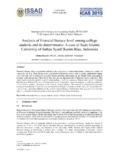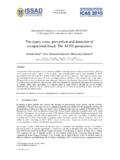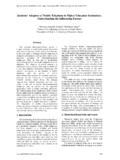Transcription of The effect analysis of cognitive and personal …
1 Available online at International Conference on Accounting Studies (ICAS) 2015. 17-20 August 2015, Johor Bahru, Johor, Malaysia The effect analysis of cognitive and personal intention in using internet technology: An Indonesian students case study Desrir Miftah, Hesty Wulandari*. State Islamic University Sultan Syarif Kasim, Riau, Indonesia Abstract This research was designed to figure out whether cognitive factors which consist of perceived usefulness and perceived ease of use as well as personal factors which divided into computer anxiety, influencing the intentions of internet usage among students. Furthermore, this research would also like to compare the cognitive and personal model in influencing the internet use intention. We use quantitative descriptive to analyse the data gathered through questionnaires among the students of State Islamic University Sultan Syarif Kasim (UIN.)
2 SUSKA) Riau Indonesia, which actively and daily using the computer and internet technology. These students were chosen as samples through simple random sampling and processing data by using multiple linear regression analysis . The results showed that perceived usefulness from cognitive factor affecting the intention in using internet while perceived ease of use does not affect the intention of using the internet. It is also found that anxiety computer from personal factors does not affect the intention in using internet technology. Oppositely, the intentions feelings affect the intention in using internet technology. When it comes to the comparison, it could be concluded that cognitive factors also do not have a greater effect when compared with personal factors of students in using internet.
3 Keywords: cognitive , personal , intentions, internet technology 1. INTRODUCTION. The development of information systems technology, especially the Internet has already touched a large amount of users. A significant number of increasing the Internet users has been creating internet culture. The Internet also has a far-reaching influence on the development of science, by simply using a search engine such as Google and Yahoo, users will have a worldwide access to many variety of information. Compared with books and libraries, the Internet represents the extreme spread of knowledge, information and data. Besides making development in information and technology, the appearance of the Internet has also affected economic development. It triggers different types of transactions that used to be done face to face into remote transaction.
4 Towards individual users, information systems technology has benefits and direct impact, especially in increasing productivity (Hartono, 2007). Some research have been done in the field of information system stated that the use of personal factors are very important for predicting the use and adoption of technology (Lucas, 1981) in Nazar (2008). Researchers have also noticed that personal factors are relatively volatile, such as individual attitudes (attitudes towards computers). _____. *. Corresponding author: Tel.:+6282173697753. Email: 2015 The Authors Proceedings of the International Conference on Accounting Studies (ICAS) 2015. 17-20 August 2015, Johor Bahru, Johor, Malaysia According to Davis (1989), cognitive factors divided into perceived usability ( perceived usefulness ) and perceived ease of use.
5 perceived usefulness is described as how a person believes that technology will improve their performance. Besides that, perceived usefulness is an assertion about the decision-making process especially when a person believes that the system is useful then he/ she will use it. Conversely, if a person believes that the system is less useful, then he will not use it. perceived ease of use according to Davis et al. (1989) defined as a person's level of confidence that the use of a particular system is not required effort. Despite efforts by every person is different, but in general, to avoid rejection of users on the developed system, then the system must be easily applied by the user without removing the efforts that are considered burdensome. Since the 1980s, researchers have learned a lot of information system how and why individual behaviour using information systems.
6 Intention to behave (behavioural intention) and behaviour itself are two different things (Hartono, 2007). Intention to behave will always be an intention. In other words, intention is also the desire to perform the behaviour. Intention is not a behaviour, but the behaviour is already a real action or activity undertaken. Previous research conducted by McElroy et al. (2007) showed results that personality factors more influential than cognitive factors on the intention (intention) the use of the internet. While the research conducted by Nazar (2008) showed that cognitive models are even more influential than the model of personality to the intention of use of Internet technology. Based on the difference of the results of the two studies above, it is very interesting to do research again with reference to the research conducted by Nazar (2008).
7 This research was carried out on bachelor students in accounting from Faculty of Economics and Social Sciences UIN Suska Riau which are frequently use the internet technology to support their education and learning activities as well as for other purposes. We choose frequent internet user bachelor degree student based on the tendency of not maximal internet technology use. Due to that matter, it is interesting to look at the factors that influence it. In this study, the problem can be formulated as follows: 1. Are cognitive factors: perceived usefulness and perceived ease of use can affect the intention to use the internet 2. Are personal factors: computer anxiety and feelings can affect the intention to use the internet? 3. Are cognitive models more influence intention to use the internet than personal model?
8 2. THEORETICAL FRAMEWORK. Intention In information systems research, it is important to discover how and why individuals accept and adopt new information technology (Agarwal & Karahanna 2000). At the individual level, the use of technology was observed by examining the role of intention as a predictor of behaviour (Liu et al. 2004: Malhotra et al. 2004). This study focuses on the determinants of intention such as attitudes and personal factors influence. Intention as determinants of behaviour has been specified in the reference information systems and other disciplines (Ajzen 1991; Taylor & Todd 1995). According to the theory reasoned action which predicts behavioural intention, Intention is defined as a formed by the attitude and subjective norm which is set up a trust. The theory is based on a model to predict the behaviour of the activities under the control of volitional.
9 Volitional control tools are fully capable use for controlling the performance of an activity. In case of non-volitional controlling activity, the theory reasoned action (TRA) suitable because it has additional component of behaviour perceived as determinants of intention. As the adaptation of TRA, there is Technology Acceptance Model (TAM) which determines the antecedent information system usage through a system of beliefs and ease of use of an information system (Davis, 989B). cognitive (Perception). cognitive psychology is the scientific knowledge of psychology that studies cognition, namely the mental processes that underlie behaviour. cognitive psychology has extensive domain research including working memory, attention, perception and knowledge representation, reasoning, creativity and problem solving (Hartono, 2007).
10 One theory about the use of information technology systems that are considered highly influential and is commonly used to describe an individual acceptance of the use of information systems technology is the Technology Acceptance Model or TAM. This theory was first introduced by Davis (1986). TAM developed from the theory of reasoned action or TRA by Ajzen and Fishbein (1980). cognitive factors in this study using the basic research with high validity of the instrument, which is based on research Davis (1989), namely: perceived usefulness and perceived ease of use. 58. Proceedings of the International Conference on Accounting Studies (ICAS) 2015. 17-20 August 2015, Johor Bahru, Johor, Malaysia Personality Personality defined as a set of characteristics and a stable trend that determines the commonalities and differences of thoughts, feelings and actions (Maddi, 1989).




